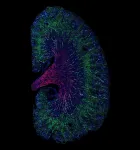(Press-News.org) A smartphone-based eye screening and referral system used in the community has been shown to almost triple the number of people with eye problems attending primary care, as well as increasing appropriate uptake of hospital services, compared to the standard approach. The new findings come from research carried out in Kenya, published in The Lancet Digital Health.
The randomised controlled trial included more than 128,000 people in Trans Nzoia County, Kenya, and was carried out by researchers from the International Centre for Eye Health (ICEH) at the London School of Hygiene & Tropical Medicine, Kitale County Hospital, the University of Nairobi and Peek Vision.
The results demonstrate the potential of using mHealth tools such as the Peek Community Eye Health system (Peek CEH) evaluated in this trial, to improve access to care, target limited eye health resources, and manage more patients effectively at the primary level so that hospitals can focus on more complex cases.
In low- and middle-income populations, limited access to eye services and a shortage of eye care providers mean there is a high prevalence of avoidable vision impairment. Globally, more than 1.1 billion people have a vision problem that is preventable or treatable, often with something as simple as glasses or a cataract operation. Key barriers to care include a lack of access to and awareness of eye services.
Peek CEH is a smartphone-based referral system which includes vision screening, SMS reminders to those requiring follow-up appointments, and real-time reporting to follow the patient journey to see who is accessing follow-up care and receiving treatment. The system evaluated in this trial also incorporated a scientifically validated decision-guiding app1 which enables non-specialist community volunteers to accurately identify and refer patients to eye services.
In the trial, 36 community unit clusters (defined as a health centre and its catchment population) were assigned at random to receive either the Peek Community Eye Health System (intervention group) or the standard approach of health-centre based outreach clinics (control group).
For the intervention group, community volunteers assessed participants' vision through door-to-door screening at home using the decision-guiding app. If the screener identified an eye problem, the participant was automatically referred for triage assessment and received regular personalised SMS reminders about their appointment.
Community sensitisation (posters and verbal notices in churches and schools) was carried out in both groups, followed by a triage clinic at the linked health facility four weeks later. During triage, participants in both groups were assessed and treated, and were referred on to Kitale Eye Unit (hospital) if further treatment was required. Participants in the intervention group received further SMS reminders about their hospital appointment.
The researchers found that the average attendance rate at triage by participants with eye problems was considerably greater in the intervention group where the Peek Community Eye Health system was used compared to the control group (1,429 per 10,000 participants in the intervention group, compared with 522 per 10,000 in the control group - a rate difference of 906 per 10,000 people). The average hospital attendance rate for those with eye problems was also greater (82 per 10,000 in the intervention group compared with 33 per 10,000 in the control group - a rate difference of 49 per 10,000).
Study lead author, Dr Hillary Rono, ICEH and Peek researcher and Ophthalmologist at Kitale Eye Hospital, said: "My experience as one of very few eye doctors in this rural region of Kenya has shown me that we need more innovative ways to get eye care services to the many people who require them. Our findings show the great potential of using the Peek Community Eye Health system to help ensure that limited health resources are effectively maximised.
"Our previous research has demonstrated that community volunteers using the decision-guiding app were almost as effective at identifying and referring patients with eye problems as an experienced eye health professional. These new findings now show that using this app to assess people's vision in their homes as part of the wider Peek CEH leads to many more people accessing the appropriate level of care, which will in many cases transform their lives."
Importantly, the researchers found that the increase in people with eye problems accessing care did not mean that the hospital became overwhelmed, because most patients (76%) were managed at the primary level. In fact, when the team compared data obtained in a previous study, they found that the number of patients attending hospital remained at a similar level during the trial, but that the hospital eye services were being used more effectively. A much lower proportion of people attended hospital for eye problems that could have been treated at the primary level (17.1 % during the trial v 61% previously observed), while the proportion being treated for more serious conditions such as cataract rose from 8% to 62.9%.
Study co-author, Dr Andrew Bastawrous, Peek Vision CEO and ICEH researcher, said: "This study is incredibly exciting as it demonstrates real systems change. This change resulted in the right people getting the right services at the right location, while the specialist services gained much needed capacity to focus on more complex conditions despite a big increase in demand overall being generated. As populations grow and age, the number of people being left behind is increasing. We are delighted to see that this is an evidence-based approach to tackle the growing vision crisis."
The authors note some study limitations, including an SMS message distribution error which was taken into account through further data analysis, and low overall screening coverage, suggesting other approaches to screening should be considered including repeated visits to households to ensure participants are home.
INFORMATION:
Peek CEH is developed by Peek Vision, an organisation that develops smartphone technology and public health tools to help eye health organisations improve their services. Peek is currently supporting health providers, NGOs and governments to deliver community or school eye health programmes and population-based surveys in multiple countries across Africa and Asia. The decision guiding door-to-door app used within Peek CEH in this trial is not yet widely available as part of Peek's eye health technology solutions.
The trial was funded by The Queen Elizabeth Diamond Jubilee Trust.
The initial chemotherapy of aggressive childhood nerve tumors, so-called high-risk neuroblastomas, is crucial for ultimate survival. It has now been shown that the chemotherapy regimen used by the European Neuroblastoma Study Group is equally efficacious but better tolerated than a highly effective regimen from the US. This was the conclusion of an international trial coordinated by St. Anna Children's Cancer Research Institute. The study was published in the prestigious Journal of Clinical Oncology.
For particularly aggressive nerve tumors in children, so-called high-risk neuroblastomas, various ...
In two separate articles in the Annals of Neurology, clinicians in India and England report cases of a rare neurological disorder called Guillain-Barre? syndrome after individuals were vaccinated against COVID-19.
Both reports describe an unusual variant of Guillain-Barre? syndrome characterized by prominent facial weakness. Seven cases were reported from a regional medical center in Kerala, India, where approximately 1.2 million people were vaccinated with the AstraZeneca COVID-19 vaccine. Four cases were reported from Nottingham, England, in an area in which approximately 700,000 people received the same vaccine. All eleven cases were among people who had received that vaccine 10-22 days earlier.
The frequency of Guillain-Barre? ...
WACO, Texas (June 21, 2021) - A new analysis of Venus' surface shows evidence of tectonic motion in the form of crustal blocks that have jostled against each other like broken chunks of pack ice. Published in the PNAS (Proceedings of the National Academy of Sciences), the study -- which includes contributions by Baylor University planetary physicist Peter James, Ph.D. -- found that the movement of these blocks could indicate that Venus is still geologically active and give scientists insight into both exoplanet tectonics and the earliest tectonic activity on Earth.
"We have identified a previously unrecognized pattern of tectonic deformation on Venus, one that is driven by interior motion just like on Earth," said Paul Byrne, Ph.D., associate professor of planetary ...
Women's electoral candidacies skyrocketed nationwide in the wake of the 2016 presidential election, which many saw as good news for democracy. But behavioral scholars have long maintained that women are more risk-averse than men, and thus are not as likely to sustain a prolonged political career -- involving election losses as well as wins -- the way men candidates traditionally have.
But behavioral scholars have long maintained that women are more risk-averse than men, and thus are not as likely to sustain a prolonged political career -- involving election losses as well as wins -- the way men candidates traditionally have.
Further, naysayers in a variety of media clips voiced that women were "sore losers," and they ...
The idea that a small number of "bad apples" are responsible for an outsized share of complaints against police officers has gained considerable traction over the last four decades. A new study considered the extent to which police misconduct is likely to be reduced by removing police officers identified early in their careers as being at risk for misconduct. The study concluded that replacing the top 10 percent of police identified as being the most likely to generate use-of-force complaints with officers who have not or are less likely to do so would reduce use-of-force complaints by just 6 percent over a 10 year period.
Conducted by researchers at the University of Pennsylvania and Princeton University, the study appears in Criminology & Public Policy, ...
If you've ever been in a city's central core in the middle of summer, you know the heat can be brutal--and much hotter than in the surrounding region.
Temperatures in cities tend to be several degrees warmer than in its rural areas, a phenomenon called the Urban Heat Island (UHI) effect. Many cities have been observed to be 2-4ºC warmer than the countryside in virtually every inhabited continent. This phenomenon occurs because urban infrastructure, especially pavements, absorbs a lot of heat as compared to natural vegetated surfaces. This heat pollution causes higher air conditioning and water costs, while also posing a public health hazard.
One mitigation strategy called gray infrastructure involves the ...
NEW YORK, NY--COVID vaccine surveillance efforts are a global priority, but safety monitoring for vaccines should not reflect a single population. The largest, most extensive international study of the background rates of adverse events of special interest (AESI) that are being tracked in vaccine surveillance efforts show that adverse event rates vary substantially by age, sex, and method of data capture.
Led by researchers at Oxford University, Columbia University, Erasmus MC, UCLA, and Janssen, an international team of collaborators from the Observational Health Data Sciences and Informatics (OHDSI) network provided a timely reference of the background rates of AESIs in a new study published ...
A research team led by the University of Arizona has reconstructed in unprecedented detail the history of a dust grain that formed during the birth of the solar system more than 4.5 billion years ago. The findings provide insights into the fundamental processes underlying the formation of planetary systems, many of which are still shrouded in mystery.
For the study, the team developed a new type of framework, which combines quantum mechanics and thermodynamics, to simulate the conditions to which the grain was exposed during its formation, when the solar system was a swirling disk of gas ...
The USC Stem Cell laboratory of Andy McMahon has identified a type of injured cell that might contribute to the transition from an acute kidney injury to chronic kidney disease, as described in a new study published in the Proceedings of the National Academy of Sciences (PNAS). The same issue of PNAS also features an accompanying Q&A with McMahon to mark his recent election as a member of the National Academy of Sciences.
"Acute kidney injury can be a common side effect of surgery, sepsis or certain prescription drugs, and there is no effective treatment," said McMahon, who is the W.M. Keck Provost and University Professor of Stem Cell Biology and Regenerative Medicine, and Biological Sciences at USC. "Even a mild or moderate injury can progress into chronic ...
CAMBRIDGE, Mass. - Women who lose local or state elections are just as likely to run for office again as men, suggesting the recent surge in women running for office may have a long-term impact on women's political representation, according to a new study by researchers from Harvard and the University of California, Davis.
Pundits and scholars have argued that women are more likely to abandon politics after a losing campaign than men, citing evidence that women are more risk-averse and more likely to avoid competition than men.
Political scientists Rachel Bernhard, assistant professor at UC-Davis, and Justin de Benedictis-Kessner, assistant professor of public policy at Harvard Kennedy School, ...



